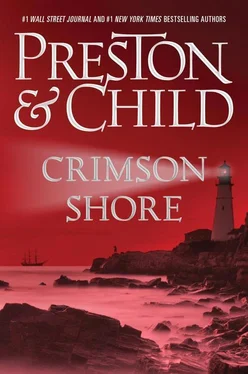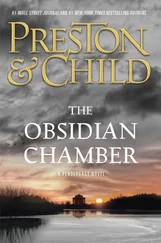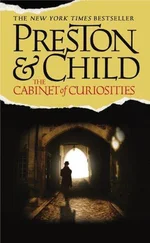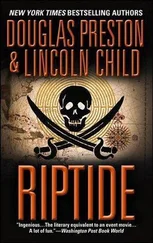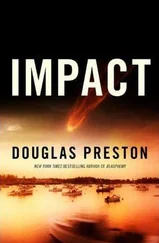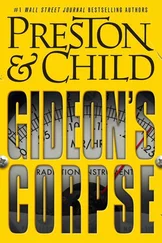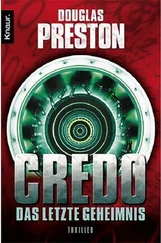“I do not.”
“So why this bit of theater? Why bring us up here to show us the coastline — rather a long coastline, I might point out — where this ship might have been wrecked deliberately — when all this is speculation?”
A brief pause, then Pendergast answered. “To keep you — as you yourself requested — ‘in the loop.’”
Lake sighed. “Well, all right, fair enough. Thank you.”
The pause that followed this was longer. Lake, wondering if perhaps he’d spoken too bluntly, took another tack. “And you think these same people who ransacked my cellar killed the historian?”
“Yes.”
“What about the other murder — Dana Dunwoody?”
“That is less clear. There is much that remains to be done. First, as you so helpfully pointed out, we must find hard evidence of the Pembroke Castle ’s fate. And then we must determine why the killers carved the so-called Tybane Inscriptions into their victims’ corpses.”
Lake nodded. “There’s a lot of disagreement around town about that. Half think the murders are the work of a group of idiots playing at witchcraft. The rest insist the inscription business is a red herring to mislead the police.”
“That is precisely the dilemma we must solve.”
“But you don’t think it might be people seriously practicing witchcraft?” Carole asked.
“That is an open question.”
“Come now!” said Lake with a laugh. “Those witch legends are just that — legends!”
This time it was Constance who spoke up. “I’m afraid not,” she said. “I’ve learned that a coven of witches did indeed settle in the marshes in the late seventeenth century after fleeing Salem. And the colony did not die out. It relocated, somewhere to the south.”
Lake looked at Carole. Her face was pale and frightened. He could well understand it — the thought that the people who had ransacked their basement were not only thieves but murderers was disturbing indeed. But witches? That was truly ridiculous.
“And now, Mr. Lake, you are fully apprised of the state of the investigation. If you’ll excuse us, we’ll get back to the business at hand.” And with that, Pendergast led the way down the circular stairway from the lighthouse tower in silence, Lake bringing up the rear, descending slowly and thoughtfully.
It was half past two when Pendergast parked the Porsche Spyder at the end of Dune Road. He got out of the car and Constance did the same, watching as he opened the trunk and extracted a metal detector and a canvas satchel full of equipment. He was wrapped up against the weather in a sou’wester and heavy oilskin coat. The day had grown grayer still, the air so humid it seemed composed of tiny droplets of salt water. Yet there was no fog, and the visibility was good: she could see the Exmouth lighthouse, where they had spent part of the morning talking to Lake, about a mile to the north.
She followed Pendergast along a narrow, sandy path toward the water. Where the path rose to a height of land he paused, gazing eastward, his head moving almost imperceptibly as he scrutinized the coastline. The afternoon had grown chill as well as gray, and Constance’s concession to it had been to dress in a Fair Isle sweater and midcalf skirt of muted tweed.
Constance was familiar with Pendergast’s silences, and she was comfortable spending time with her own thoughts, but after fifteen minutes she felt impatience getting the better of her. “I know you don’t like to be asked prying questions, but what are we doing here?”
For a moment, Pendergast did not reply. Then he broke off his scrutiny to turn toward her. “I fear our sculptor friend has a point. My theory about the shipwreck remains a figment of my cerebrum. We are here to gain proof.”
“But the Pembroke Castle was lost a hundred and thirty years ago. What kind of proof can we find after all these years?”
“Recall what I told you before.” And he pointed south toward a distant section of the coast that angled sharply outward into the sea. “That hook of the shoreline would act as a net. If a ship had foundered on it, there would have been debris.”
Constance glanced in the indicated direction. “How can you make such a deduction from the current topography? Surely thirteen decades of storms would have altered the shoreline.”
“Were we on Cape Cod, I might agree with you. But the coastline here is sand interspersed with rocky areas that act like a series of natural breakwaters, preserving its shape.”
He fell silent again, making another survey of the windswept scene. Then he reshouldered the satchel. “Shall we?”
Constance followed him down the bluff toward the shoreline. This section was studded with cruel-looking boulders as big as automobiles. Even at this distance she could see that their flanks were covered with razor-sharp barnacles. The surf thundered among them, sending up huge spumes that lingered in the heavy air. Spindrift blew off the angry combers that rolled in ceaselessly toward land.
Pendergast stopped well short of the rocks. He laid the metal detector on the ground, then removed a GPS unit, binoculars, digital camera, and a mysterious device, which he placed on the ground as well. Next, he drew out a map and unfolded it, holding down the corners with stones. Constance saw that it was a large-scale topographical map of the Exmouth region, with a ratio of 1:24,000, heavily notated in Pendergast’s neat script. He examined the map for several minutes, frequently looking up from it to scrutinize some point along the coastline. Then he folded it back up and replaced it in the satchel.
“Eleven thirty PM,” he said, more to himself than to Constance. “The wind would have been blowing from that direction.” He looked northeast, toward the lighthouse. “And the light would have been extinguished.”
He picked up the GPS and the strange device and began walking southwestward, moving tangentially to the shoreline. Constance followed, waiting as he paused now and then to consult the GPS. He stopped at a point that placed them between the lighthouse and a nasty line of jagged rocks that stretched out into the sea.
“The bonfire would have been built well back on shore, and on a high point, perhaps the crest of a dune,” he murmured. “It would not have been a large fire — maintaining an illusion of distance being important — but it would have burned hot and bright.”
More pacing back and forth; more consulting with the GPS unit. Then, taking the sou’wester from his head and stuffing it into a pocket of his coat, Pendergast lifted the unknown device and pointed it in various directions, sighting along it as a surveyor might sight along a theodolite.
“What is that?” Constance asked.
“Laser range finder.” Pendergast took a number of measurements, comparing them to the GPS readout. After each measurement, he moved to a new location. Each move was progressively smaller.
“Here,” he said at last.
“Here what?” she said, half exasperated with Pendergast’s inscrutability.
“Here would have been the ideal place to situate the bonfire.” He nodded south, toward the fang-like series of rocks surrounded by blistering surf. “That reef is known as Skullcrusher Rocks. You will note that our location lies on a line with the Exmouth lighthouse, but in such a fashion as to place Skullcrusher Rocks, there, between the lighthouse and a passing ship. A ship on a southerly course, keeping near the shelter of the coast because of the storm, would have used the Exmouth Light to guide it around the northern shore of Cape Ann. If you move the light a mile south, the ship, using the false light as its bearing, would steam right into those rocks — which on a dirty night would be invisible.”
Читать дальше
